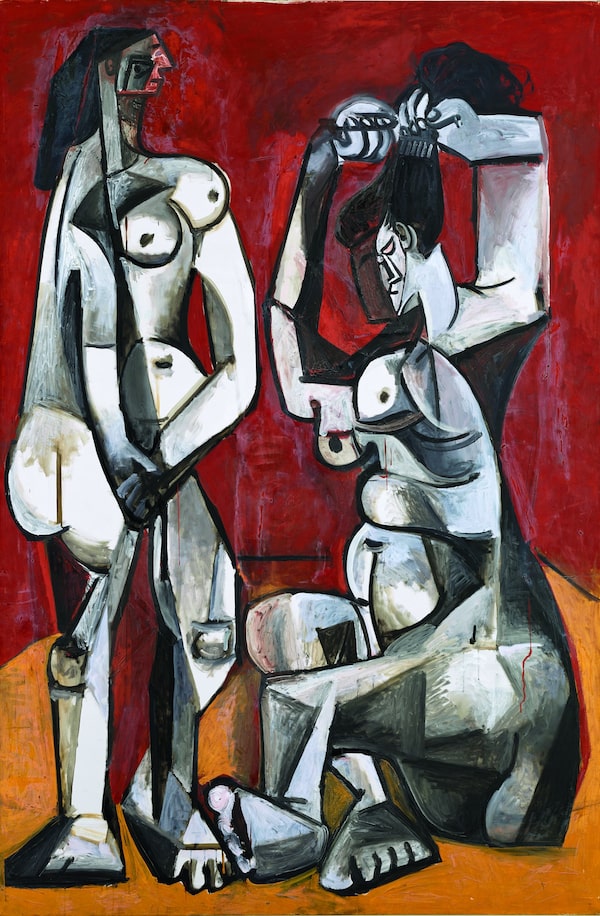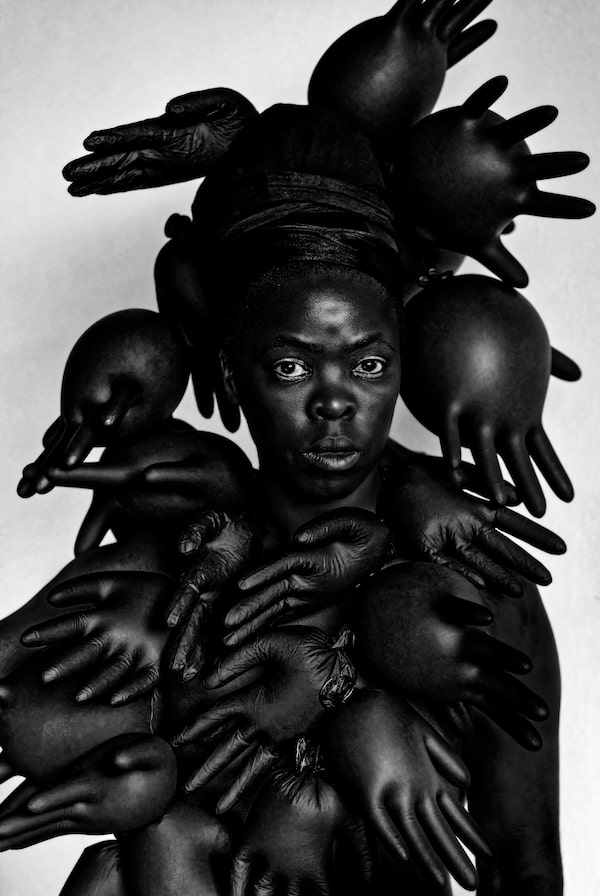In 1907, Pablo Picasso visited Paris’s Trocadero Museum, a repository for objects particular to France’s colonies. He had an epiphany of sorts while looking at carved African masks, which were becoming central to a craze for exotic tokens from “primitive” societies. Picasso, however, revered the masks’ anonymous makers, for showing, as he said, that “art is not an aesthetic process [but] a form of magic.” Their influence on his work continued long after what he called his “période nègre” ended in 1909.
Picasso’s debt to non-European artists has become a dynamic topic as museums try to decolonize their view of art and art-making. A current exhibition at the Montreal Museum of Fine Arts displays nearly 100 pieces by Picasso, alongside the kinds of work that thrilled him at the Trocadero, as well as contemporary art by young Africans.
It’s a show in which several narratives overlap and sometimes grind against each other. There’s the tale of the great European painter, plundering and transforming images delivered to him by an actual plundering empire. There’s the newer story of artists from former colonies who subvert the iconography of “the primitive,” and reappropriate aspects of European art history.
There’s also a tale of art institutions evolving away from the notion that art is primarily what Europeans make, and that the cultural productions of other peoples are ethnological. The old assumption that Picasso elevated the things he borrowed - including ancient Iberian imagery – is not on.
Much as the curators try to present Picasso as one artist in equal dialogue with others, however, his renown still makes this show seem at times like yet another attempt to trace his sources. This may be an exhibition you need to see twice: the first time looking at everything; the second time, ignoring the Picassos. Here’s our portfolio of six items from this provocative show.
Anthropomorphic mask, anonymous Dan artist, 20th century

This gunye ge or “running” mask was made to be worn by young men competing with each other in foot races.Claude Germain
The Dan people, whose homeland stretches across parts of Côte d’Ivoire and Liberia, are prolific makers of wooden masks, some of which represent birds and animals. This gunye ge or “running” mask was made to be worn by young men competing with each other in foot races. Its simplicity and symmetry imply an ideal of male beauty.
Buste d’homme, Pablo Picasso, 1907

Picasso’s mask-like oil of a young man outlines the features with minimal, simplified lines.RMN / RenÈ-Gabriel OjÈd
“Two holes are the sign of the face, sufficient to evoke it without representing it,” Picasso said. His mask-like oil of a young man outlines the features with minimal, simplified lines. The man doesn’t appear in the work for which he was a study: the career-making Les Demoiselles d’Avignon (1907). Perhaps he was meant to be a prospective client of the female sex workers depicted in the painting – which might explain his wink.
Emmanuel C. Bofala, Tipo Passe, Edson Chagas, 2014

This work by Chagas is partly a play on how masks have become a stereotyped signifier of Africanness.Edson Chagas
Chagas is an Angolan photographer who won the Golden Lion at the Venice Biennale in 2013. His large-scale series Tipo Passe (Portuguese for passport) depicts models in a format standard for official documents, except for the masks that replace the features with an impersonal but regionally specific identity. The work is partly a play on how such masks have become a stereotyped signifier of Africanness.
Femmes à la toilette, Picasso, 1956

With Femmes à la toilette, Picasso revisits a favourite scenario for male painters, while giving his two bathers a heft that’s more monumental than erotic.Mathieu Rabeau / RMN-GP
Picasso revisits a favourite scenario for male painters, while giving his two bathers a heft that’s more monumental than erotic. The figures might have been hacked from stone. They defy a single perspective with cubistic displacements that may have seemed out of place in 1956. The fifties were still okay, however, with the eternal-woman archetype that Picasso seems to be seeking, albeit in non-naturalistic fashion.
Phila I, Parktown, Zanele Muholi, 2016

In this image, Zanele Muholi parodies traditional views of women as mere vessels for childbearing.
The South African artist, a graduate of Toronto’s Ryerson University, shot a self-portrait every day for a year, and called the results Somnyama Ngonyama (Hail the Dark Lioness). In this image, she parodies traditional views of women as mere vessels for childbearing. The inflated latex gloves that protrude like udders from her head and body underscore the travesty of limiting women to their animal functions.
La deesse de l’amour, Romuald Hazoume, 2012

Hazoumè’s wooden love goddess wears a skirt made of chain-link and hundreds of ‘love locks.’
Hazoumè, a Yoruba artist from Benin, may be best known for satirical, tribal-style masks made from gasoline cans. His wooden love goddess wears a skirt made of chain-link and hundreds of “love locks,” of the kind couples fasten to fences and bridges as tokens of devotion. You’re supposed to throw away the keys, but Hazoumè’s goddess, true to her fickle nature, wears them in her necklace and earrings.